Cohen I.M., Kundu P.K. Fluid Mechanics
Подождите немного. Документ загружается.

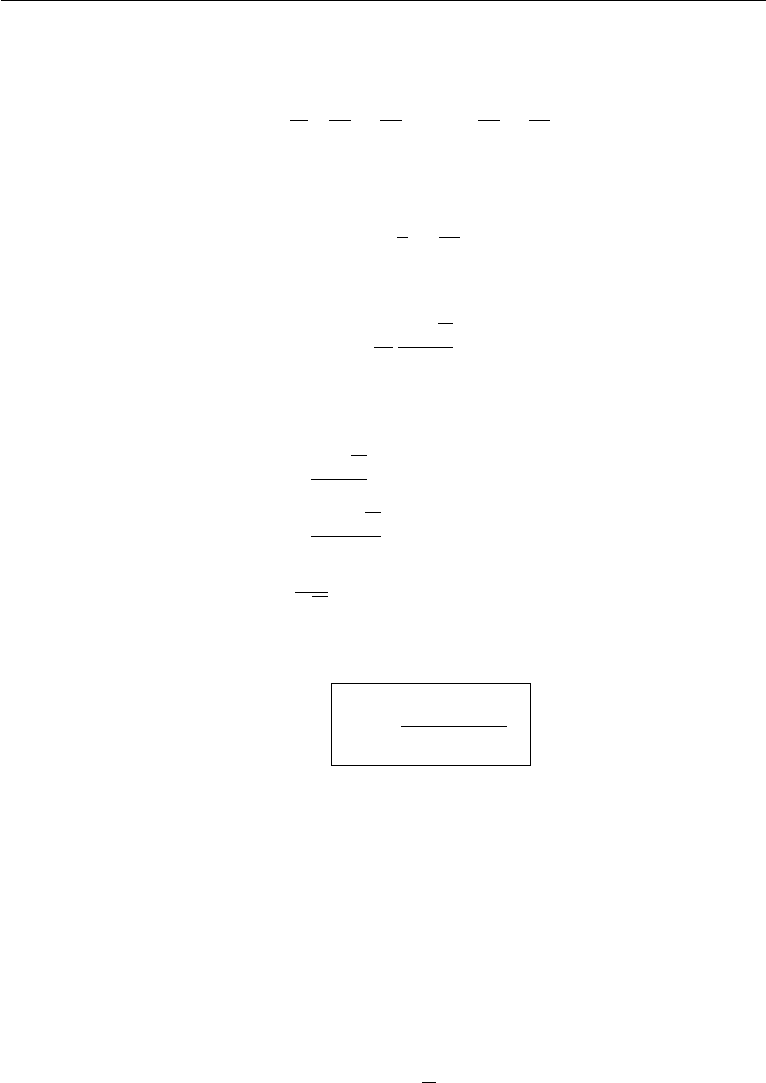
652 Geophysical Fluid Dynamics
An expression for ˆv can now be obtained from the horizontal equations of motion
in equation (14.95). Cross differentiating, we obtain the vorticity equation
∂
∂t
∂u
∂y
−
∂v
∂x
= f
∂u
∂x
+
∂v
∂y
.
Using the wave solution equation (14.97), this gives
ˆu
ˆv
=
iω
f
.
Equation (14.106) then gives
ˆv =±
if
ω
A
0
√
m
k
e
±i
z
mdz
. (14.107)
Taking real parts of equations (14.104), (14.106), and (14.107), we obtain the velocity
field
u =∓
A
0
√
m
k
cos
kx ±
z
mdz− ωt
,
v =∓
A
0
f
√
m
ωk
sin
kx ±
z
mdz− ωt
,
w =
A
0
√
m
cos
kx ±
z
mdz− ωt
,
(14.108)
where the dispersion relation is
m
2
=
k
2
(N
2
− ω
2
)
ω
2
− f
2
. (14.109)
The meaning of m(z) is clear from equation (14.108). If we call the argument of the
trigonometric terms the “phase,” then it is apparent that ∂(phase)/∂z = m(z), so that
m(z) is the local vertical wavenumber. Because we are treating k, m, ω>0, it is also
apparent that the upper signs represent waves with upward phase propagation, and
the lower signs represent downward phase propagation.
Particle Orbit
To find the shape of the hodograph in the horizontal plane, consider the point
x = z = 0. Then equation (14.108) gives
u =∓cos ωt,
v =±
f
ω
sin ωt,
(14.110)
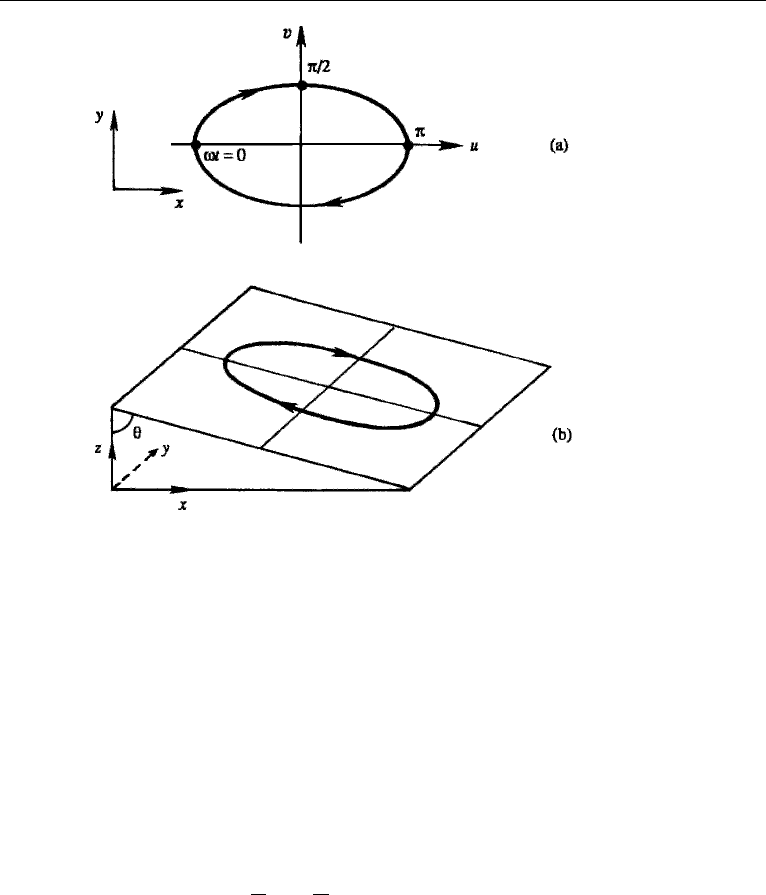
14. Internal Waves 653
Figure 14.22 Particle orbit in an internal wave. The upper panel (a) shows projection on a horizontal plane;
points corresponding to ωt = 0, π/2, and π are indicated. The lower panel (b) shows a three-dimensional
view. Sense of rotation shown is valid for the northern hemisphere.
where the amplitude of u has been arbitrarily set to one. Taking the upper signs in
equation (14.110), the values of u and v are indicated in Figure 14.22a for three values
of time corresponding to ωt = 0, π/2, and π. It is clear that the horizontal hodographs
are clockwise ellipses, with the major axis in the direction of propagation x, and the
axis ratio is f/ω. The same conclusion applies for the lower signs in equation (14.110).
The particle orbits in the horizontal plane are therefore identical to those of Poincar´e
waves (Figure 14.15).
However, the plane of the motion is no longer horizontal. From the velocity
components equation (14.108), we note that
u
w
=∓
m
k
=∓tan θ, (14.111)
where θ = tan
−1
(m/k) is the angle made by the wavenumber vector K with the
horizontal (Figure 14.23). For upward phase propagation, equation (14.111) gives
u/w =−tan θ, so that w is negative if u is positive, as indicated in Figure 14.23.
A three-dimensional sketch of the particle orbit is shown in Figure 14.22b. It is easy
to show (Exercise 6) that the phase velocity vector c is in the direction of K, that c
and c
g
are perpendicular, and that the fluid motion u is parallel to c
g
; these facts are
demonstrated in Chapter 7 for internal waves unaffected by Coriolis forces.
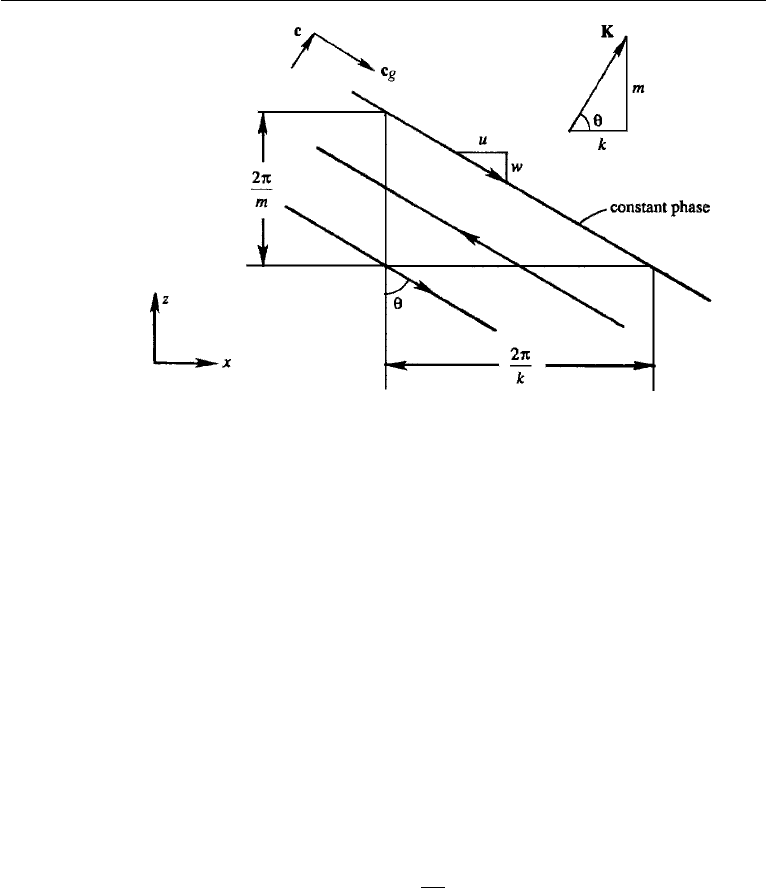
654 Geophysical Fluid Dynamics
Figure 14.23 Vertical section of an internal wave. The three parallel lines are constant phase lines, with
the arrows indicating fluid motion along the lines.
The velocity vector at any location rotates clockwise with time. Because of the
vertical propagation of phase, the tips of the instantaneous vectors also turn with depth.
Consider the turning of the velocity vectors with depth when the phase velocity is
upward, so that the deeper currents have a phase lead over the shallower currents
(Figure 14.24). Because the currents at all depths rotate clockwise in time (whether
the vertical component of c is upward or downward), it follows that the tips of the
instantaneous velocity vectors should fall on a helical spiral that turns clockwise with
depth. Only such a turning in depth, coupled with a clockwise rotation of the velocity
vectors with time, can result in a phase lead of the deeper currents. In the opposite case
of a downward phase propagation, the helix turns counterclockwise with depth. The
direction of turning of the velocity vectors can also be found from equation (14.108),
by considering x = t = 0 and finding u and v at various values of z.
Discussion of the Dispersion Relation
The dispersion relation (14.109) can be written as
ω
2
− f
2
=
k
2
m
2
(N
2
− ω
2
). (14.112)
Introducing tan θ = m/k, equation (14.112) becomes
ω
2
= f
2
sin
2
θ +N
2
cos
2
θ,
which shows that ω is a function of the angle made by the wavenumber with the
horizontal and is not a function of the magnitude of K.Forf = 0 the forementioned
expression reduces to ω = N cos θ, derived in Chapter 7, Section 19 without Coriolis
forces.
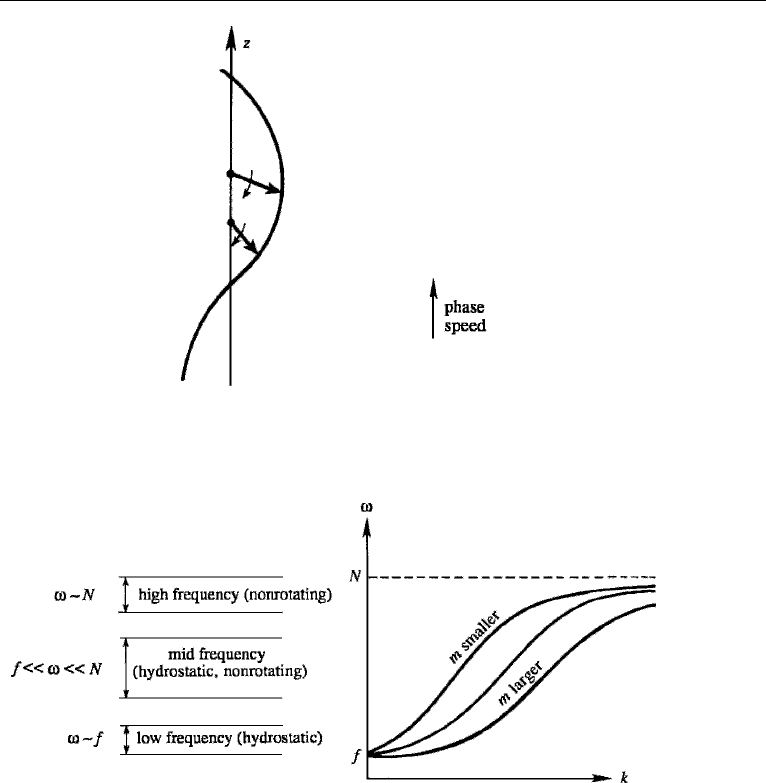
14. Internal Waves 655
Figure 14.24 Helical spiral traced out by the tips of instantaneous velocity vectors in an internal wave
with upward phase speed. Heavy arrows show the velocity vectors at two depths, and light arrows indicate
that they are rotating clockwise with time. Note that the instantaneous vectors turn clockwise with depth.
Figure 14.25 Dispersion relation for internal waves. The different regimes are indicated on the left-hand
side of the figure.
A plot of the dispersion relation (14.112) is presented in Figure 14.25, showing
ω as a function of k for various values of m. All curves pass through the point ω = f ,
which represents inertial oscillations. Typically, N f in most of the atmosphere
and the ocean. Because of the wide separation of the upper and lower limits of the
internal wave range f ω N, various limiting cases are possible, as indicated in
Figure 14.25. They are
(1) High-frequency regime (ω ∼ N,but ω N): In this range f
2
is negligible
in comparison with ω
2
in the denominator of the dispersion relation (14.109),
which reduces to

656 Geophysical Fluid Dynamics
m
2
k
2
(N
2
− ω
2
)
ω
2
, that is,ω
2
N
2
k
2
m
2
+ k
2
.
Using tan θ = m/k, this gives ω = N cos θ . Thus, the high-frequency inter-
nal waves are the same as the nonrotating internal waves discussed in
Chapter 7.
(2) Low-frequency regime (ω ∼ f, but ω f ): In this range ω
2
can be neglected
in comparison to N
2
in the dispersion relation (14.109), which becomes
m
2
k
2
N
2
ω
2
− f
2
, that is,ω
2
f
2
+
k
2
N
2
m
2
.
The low-frequency limit is obtained by making the hydrostatic assumption,
that is, neglecting ∂w/∂t in the vertical equation of motion.
(3) Midfrequency regime (f ω N ): In this range the dispersion relation
(14.109) simplifies to
m
2
k
2
N
2
ω
2
,
so that both the hydrostatic and the nonrotating assumptions are applicable.
Lee Wave
Internal waves are frequently found in the “lee” (that is, the downstream side) of
mountains. In stably stratified conditions, the flow of air over a mountain causes
a vertical displacement of fluid particles, which sets up internal waves as it moves
downstream of the mountain. If the amplitude is large and the air is moist, the upward
motion causes condensation and cloud formation.
Due to the effect of a mean flow, the lee waves are stationary with respect to the
ground. This is shown in Figure 14.26, where the westward phase speed is canceled
by the eastward mean flow. We shall determine what wave parameters make this
cancellation possible. The frequency of lee waves is much larger than f , so that
rotational effects are negligible. The dispersion relation is therefore
ω
2
=
N
2
k
2
m
2
+ k
2
. (14.113)
However, we now have to introduce the effects of the mean flow. The dispersion
relation (14.113) is still valid if ω is interpreted as the intrinsic frequency, that is, the
frequency measured in a frame of reference moving with the mean flow. In a medium
moving with a velocity U, the observed frequency of waves at a fixed point is Doppler
shifted to
ω
0
= ω + K
•
U,
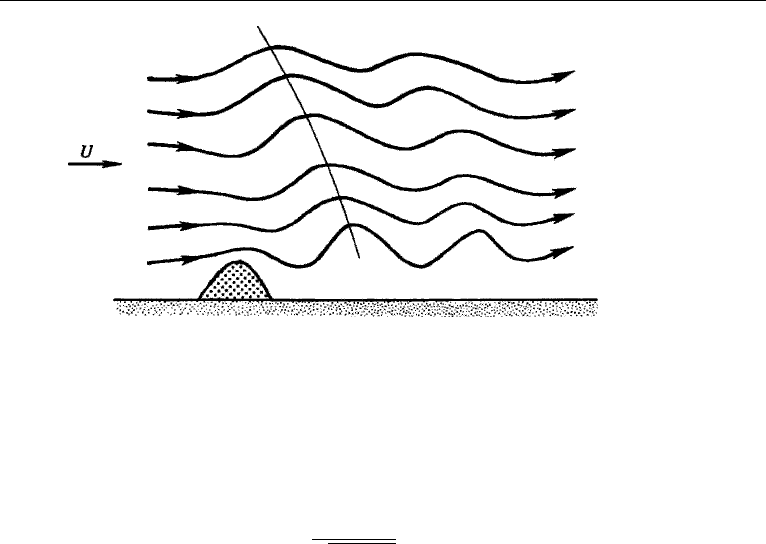
15. Rossby Wave 657
Figure 14.26 Streamlines in a lee wave. The thin line drawn through crests shows that the phase propa-
gates downward and westward.
where ω is the intrinsic frequency; this is discussed further in Chapter 7, Section 3.
For a stationary wave ω
0
= 0, which requires that the intrinsic frequency is
ω =−K
•
U = kU. (Here −K
•
U is positive because K is westward and U is
eastward.) The dispersion relation (14.113) then gives
U =
N
√
k
2
+ m
2
.
If the flow speed U is given, and the mountain introduces a typical horizontal
wavenumber k, then the preceding equation determines the vertical wavenumber
m that generates stationary waves. Waves that do not satisfy this condition would
radiate away.
The energy source of lee waves is at the surface. The energy therefore must prop-
agate upward, and consequently the phases propagate downward. The intrinsic phase
speed is therefore westward and downward in Figure 14.26. With this information,
we can determine which way the constant phase lines should tilt in a stationary lee
wave. Note that the wave pattern in Figure 14.26 would propagate to the left in the
absence of a mean velocity, and only with the constant phase lines tilting backwards
with height would the flow at larger height lead the flow at a lower height.
Further discussion of internal waves can be found in Phillips (1977) and Munk
(1981); lee waves are discussed in Holton (1979).
15. Rossby Wave
To this point we have discussed wave motions that are possible with a constant Coriolis
frequency f and found that these waves have frequencies larger than f . We shall now
consider wave motions that owe their existence to the variation of f with latitude.
With such a variable f , the equations of motion allow a very important type of wave
motion called the Rossby wave. Their spatial scales are so large in the atmosphere that
they usually have only a few wavelengths around the entire globe (Figure 14.27). This
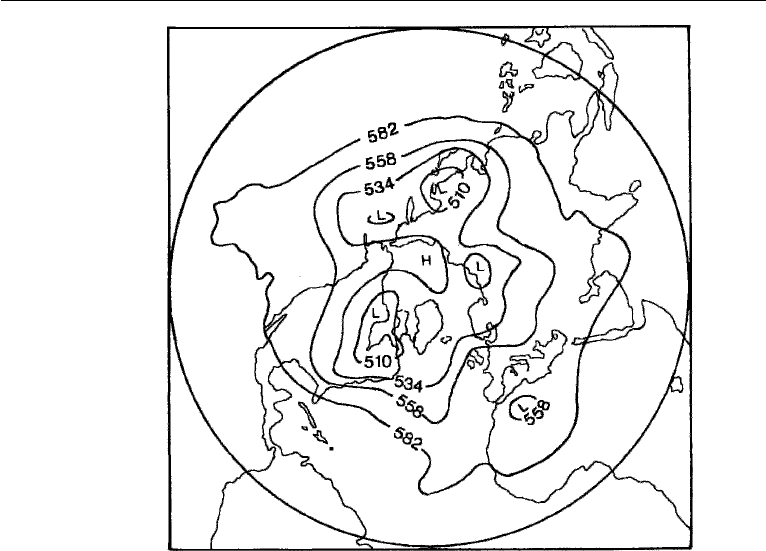
658 Geophysical Fluid Dynamics
Figure 14.27 Observed height (in decameters) of the 50 kPa pressure surface in the northern hemi-
sphere. The center of the picture represents the north pole. The undulations are due to Rossby waves
(dm = km/100). J. T. Houghton, The Physics of the Atmosphere, 1986 and reprinted with the permission
of Cambridge University Press.
is why Rossby waves are also called planetary waves. In the ocean, however, their
wavelengths are only about 100 km. Rossby-wave frequencies obey the inequality
ω f . Because of this slowness the time derivative terms are an order of magnitude
smaller than the Coriolis forces and the pressure gradients in the horizontal equations
of motion. Such nearly geostrophic flows are called quasi-geostrophic motions.
Quasi-Geostrophic Vorticity Equation
We shall first derive the governing equation for quasi-geostrophic motions. For sim-
plicity, we shall make the customary β-plane approximation valid for βy f
0
, keep-
ing in mind that the approximation is not a good one for atmospheric Rossby waves,
which have planetary scales. Although Rossby waves are frequently superposed on
a mean flow, we shall derive the equations without a mean flow, and superpose a
uniform mean flow at the end, assuming that the perturbations are small and that a
linear superposition is valid. The first step is to simplify the vorticity equation for
quasi-geostrophic motions, assuming that the velocity is geostrophic to the lowest
order. The small departures from geostrophy, however, are important because they
determine the evolution of the flow with time.
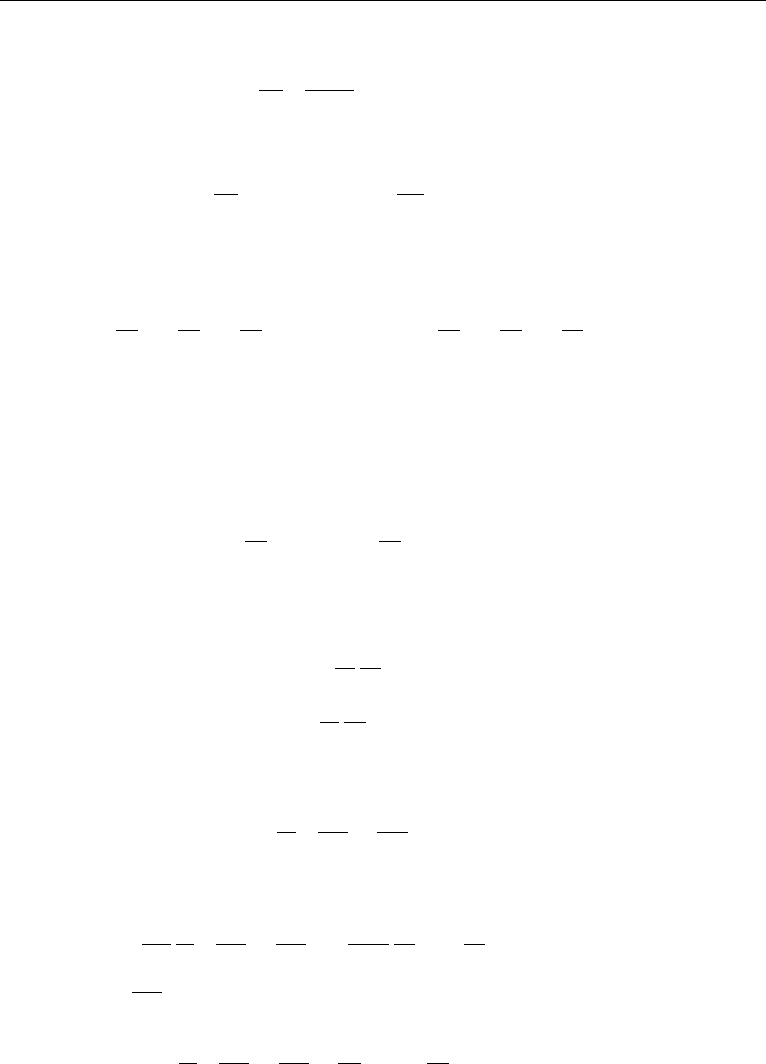
15. Rossby Wave 659
We start with the shallow-water potential vorticity equation
D
Dt
ζ + f
h
= 0,
which can be written as
h
D
Dt
(ζ + f)− (ζ + f)
Dh
Dt
= 0.
We now expand the material derivative and substitute h = H + η, where H is the
uniform undisturbed depth of the layer, and η is the surface displacement. This gives
(H + η)
∂ζ
∂t
+ u
∂ζ
∂x
+ v
∂ζ
∂y
+ βv
− (ζ + f
0
)
∂η
∂t
+ u
∂η
∂x
+ v
∂η
∂y
= 0.
(14.114)
Here, we have used Df/Dt = v(df/dy) = βv. We have also replaced f by f
0
in the second term because the β-plane approximation neglects the variation of f
except when it involves df/dy. For small perturbations we can neglect the quadratic
nonlinear terms in equation (14.114), obtaining
H
∂ζ
∂t
+ Hβv − f
0
∂η
∂t
= 0. (14.115)
This is the linearized form of the potential vorticity equation. Its quasi-geostrophic ver-
sion is obtained if we substitute the approximate geostrophic expressions for velocity:
u −
g
f
0
∂η
∂y
,
v
g
f
0
∂η
∂x
.
(14.116)
From this the vorticity is found as
ζ =
g
f
0
∂
2
η
∂x
2
+
∂
2
η
∂y
2
,
so that the vorticity equation (14.115) becomes
gH
f
0
∂
∂t
∂
2
η
∂x
2
+
∂
2
η
∂y
2
+
gHβ
f
0
∂η
∂x
− f
0
∂η
∂t
= 0.
Denoting c =
√
gH, this becomes
∂
∂t
∂
2
η
∂x
2
+
∂
2
η
∂y
2
−
f
2
0
c
2
η
+ β
∂η
∂x
= 0. (14.117)

660 Geophysical Fluid Dynamics
This is the quasi-geostrophic form of the linearized vorticity equation, which governs
the flow of large-scale motions. The ratio c/f
0
is recognized as the Rossby radius.
Note that we have not set ∂η/∂t = 0, in equation (14.115) during the derivation
of equation (14.117), although a strict validity of the geostrophic relations (14.116)
would require that the horizontal divergence, and hence ∂η/∂t, be zero. This is because
the departure from strict geostrophy determines the evolution of the flow described
by equation (14.117). We can therefore use the geostrophic relations for velocity
everywhere except in the horizontal divergence term in the vorticity equation.
Dispersion Relation
Assume solutions of the form
η =ˆηe
i(kx+ly−ωt)
.
We shall regard ω as positive; the signs of k and l then determine the direction of
phase propagation. A substitution into the vorticity equation (14.117) gives
ω =−
βk
k
2
+ l
2
+ f
2
0
/c
2
. (14.118)
This is the dispersion relation for Rossby waves. The asymmetry of the dispersion
relation with respect to k and l signifies that the wave motion is not isotropic in
the horizontal, which is expected because of the β-effect. Although we have derived
it for a single homogeneous layer, it is equally applicable to stratified flows if c is
replaced by the corresponding internal value, which is c =
g
H for the reduced
gravity model (see Chapter 7, Section 17) and c = NH/nπ for the nth mode of a
continuously stratified model. For the barotropic mode c is very large, and f
2
0
/c
2
is
usually negligible in the denominator of equation (14.118).
The dispersion relation ω(k,l)in equation (14.118) can be displayed as a surface,
taking k and l along the horizontal axes and ω along the vertical axis. The section of
this surface along l = 0 is indicated in the upper panel of Figure 14.28, and sections
of the surface for three values of ω are indicated in the bottom panel. The contours
of constant ω are circles because the dispersion relation (14.118) can be written as
k +
β
2ω
2
+ l
2
=
β
2ω
2
−
f
2
0
c
2
.
The definition of group velocity
c
g
= i
∂ω
∂k
+ j
∂ω
∂l
,
shows that the group velocity vector is the gradient of ωin the wavenumber space. The
direction of c
g
is therefore perpendicular to the ω contours, as indicated in the lower
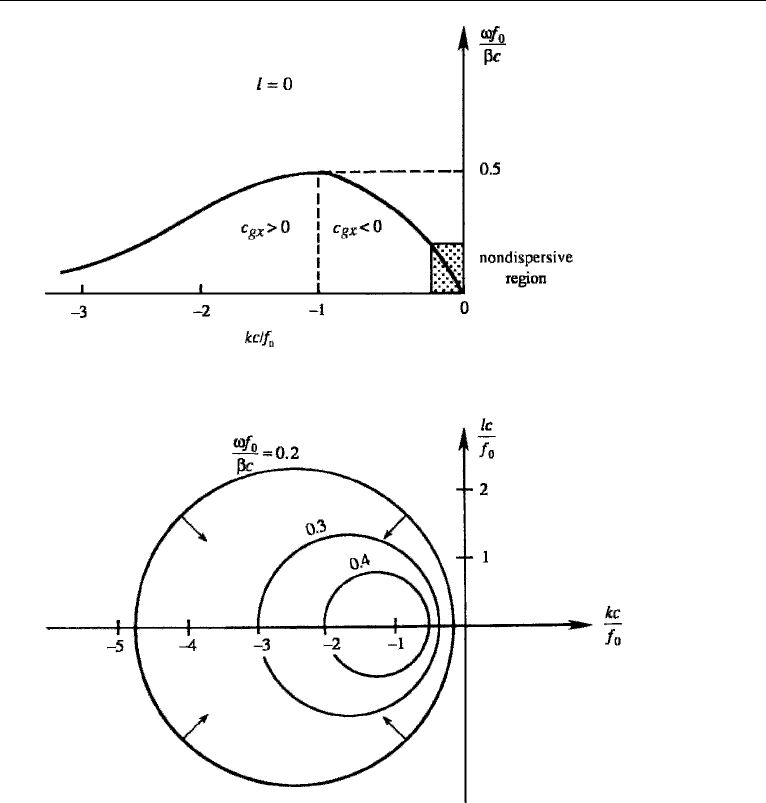
15. Rossby Wave 661
Figure 14.28 Dispersion relation ω(k,l) for a Rossby wave. The upper panel shows ω vs k for l = 0.
Regions of positive and negative group velocity c
gx
are indicated. The lower panel shows a plan view of the
surface ω(k,l), showing contours of constant ω on a kl-plane. The values of ωf
0
/βc for the three circles
are 0.2, 0.3, and 0.4. Arrows perpendicular to ω contours indicate directions of group velocity vector c
g
.
A. E. Gill, Atmosphere–Ocean Dynamics, 1982 and reprinted with the permission of Academic Press and
Mrs. Helen Saunders-Gill.
panel of Figure 14.28. For l = 0, the maximum frequency and zero group speed
are attained at kc/f
0
=−1, corresponding to ω
max
f
0
/βc = 0.5. The maximum
frequency is much smaller than the Coriolis frequency. For example, in the ocean
the ratio ω
max
/f
0
= 0.5βc/f
2
0
is of order 0.1 for the barotropic mode, and of order
0.001 for a baroclinic mode, taking a typical midlatitude value of f
0
∼ 10
−4
s
−1
,
